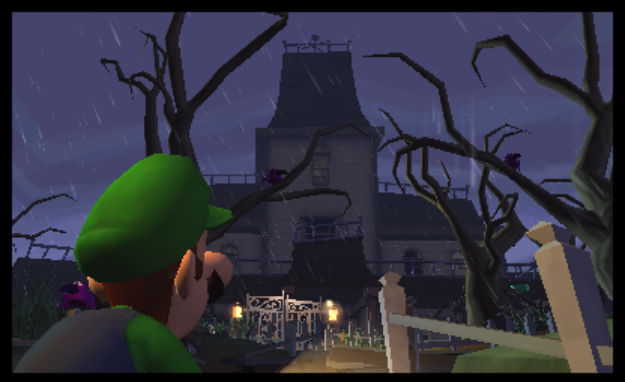
When the original Luigi’s Mansion was released in the U.S., the first Harry Potter film had just been released. Fox’s show 24 had just debuted, and Windows XP had been in stories for less than an month. Derided at the time as being at best a tech-demo for the just-launched GameCube, and at worst a stopgap letting Nintendo finish its grand follow-up to Super Mario 64, the original Luigi’s Mansion has aged into one of the last, great internally developed series from the company.

Play Luigi’s Mansion: Dark Moon on a Nintendo 3DS for a few minutes, and the 12 year break feels well worth it, rejuvenating the simple fun of guiding Mario’s lanky sibling through a haunted house, catching ghosts as you go. The basics are the same: Luigi’s still using a souped up vacuum cleaner to capture spooks and specters while experiencing feelings of dread in basements and attics. To treat Next Level Games’ effort here as just a sequel though, is a serious disservice. If Super Metroid felt like the fullest realization of what the original Metroid could be, Dark Moon does the same for Luigi’s Mansion.
Luigi’s ready to believe you
Although Nintendo dropped the name Luigi’s Mansion 2 from the game here in the US (they did keep it in Japan and Europe), this is very much a sequel, picking up after the events of the original. Slightly sadistic inventor Professor E. Gadd is hanging out in his wantonly haunted lab when a shady ghost shatters the mystical object, the Dark Moon, which plummets the surrounding country side in purple fog and makes all the local ghosts go crazy. Luigi’s just chilling at home watching TV when Gadd teleports him to his lab to ask him to head out to reclaim pieces of the Dark Moon and fight the dastardly Boo ghosts that are stirring up all the trouble.
Unlike the original game that had you exploring just one mansion, branching into different floors as new abilities were gained and conditions were met, Dark Moon is more linear, structured like a classic video game with levels. Each of the five haunted locales you visit—mansions, factories, and others—are broken into five levels with a boss waiting at the end. Getting to those bosses is a matter of solving puzzles and ferreting out ghosts.

This isn’t a break between environmental challenges and combat, like in most games though. Beating ghosts and solving puzzles are very similar activities. Before you can start sucking ghosts up with your vacuum, you have to blind them with your flashlight. Sometimes they’re wearing sunglasses to block the light, however, and they’re often hiding; part of the challenge is figuring out what in any given room you need to mess with.
A giant clock is blocking the front door to a haunted watch factory? Vacuum a crank so the hour and minute hands match another clock close by. Once you’re inside you can surprise and snatch up the ghosts. Later levels add in new abilities like a rainbow-colored attachment for your flashlight that reveal objects in the environment that ghosts have hidden, or even some ghosts themselves, adding in another layer to exploration and investigation. When Dark Moon leaves you to your own devices to figure things out, the game practically glows: Why can’t I use this water pump to grow a tree in this lab? The pipes are hidden and filled with ghosts! Awesome.
Houses haunted by little things
The levels are typically broken into small goals. Luigi and Gadd know that the Dark Moon piece hidden in Haunted Towers is in a big tree growing between these twin buildings, but Luigi can’t get inside until he’s fixed the plumbing. That’s right: Actual plumbing in a Mario Brothers game. Once that’s taken care of, he’s got to open the main gates which are locked with a weird pinwheel, but ghosts have stolen the locks of the pinwheel. Hunt them down and get inside, but then you need a key that was stolen by a playful ghost dog. In between solving each problem and running into a new one, you’re called back to Gadd’s level to be graded and wait.
At first, this structure seems like a serious drawback to the game, a stream of constant interruptions keeping you from really getting to know the game’s environments. The reality, however, is that the mansions change in each level. Maybe one room will be blocked off and you need to find an alternate route. A coffin in the sewers may just hide some money for upgrading your vacuum in one stage, but in the next it’s a portal to a little maze mini-game. The interruptions don’t block you from getting to know Dark Moon’s stages; they demand even more attention so you can notice the small differences each time through. Since each stage hides not just treasure but secret Boo ghosts, you’ll be revisiting them for multiple playthroughs throughout.

There is a staggering amount to notice, too. The original Luigi’s Mansion got its tech demo reputation because of how much of the environment was interactive. Table cloths could be sucked of tables, burning candles extinguished, etc. These sorts of physical features are common place in games today, but back then it was groundbreaking for a console game. What Dark Moon lacks in innovation it makes up for with sheer artistry. Last June, I noted in a preview of the game how remarkable the little touches were, like the very first room of the game where you can hear wind chimes tinkling in the wind. Every inch of Dark Moon is littered with that level of detail. Fountains spout water, dust and gears clutter storage rooms. Like a real haunted house, the fun is in turning the next corner and waiting to discover what’s hidden within.
The game’s multiplayer is also not much more than a fun diversion. Producer Shigeru Miyamoto apparently told Next Level Games to only include the multiplayer mode if it was as good as Mario Kart’s multiplayer. The four-player rush to collect as many ghosts as possible and move through floors of a building in a given time is nowhere near the excellence of the company’s classic go kart racing, but it’s a fun enough bonus to the game’s lengthy quest for the Dark Moon. (The game will take you about 13 hours to finish the campaign, and that’s not a 100 percent run.)
Conclusion

This isn’t the first time Next Level Games has brought a Nintendo classic out of hibernation – it was also behind Punch-Out!! for the Wii. That game sometimes felt too beholden to the series’ past – it was a nostalgic act more than anything else. Luigi’s Mansion: Dark Moon is not built on nostalgia, but a beautiful, playful game of ghost hunting. The series can go back to bed for awhile, because this is a game that will last. Here’s hoping that Next Level Games doesn’t wait as long to work on its next project with Nintendo.
Score: 8 out of 10
(This game was reviewed on the Nintendo 3DS using a copy provided by the publisher)
Editors' Recommendations
- Nintendo 2DS XL vs. Nintendo 3DS XL
- Luigi’s Mansion 3 is a hair-raising ghost adventure fit for Halloween


